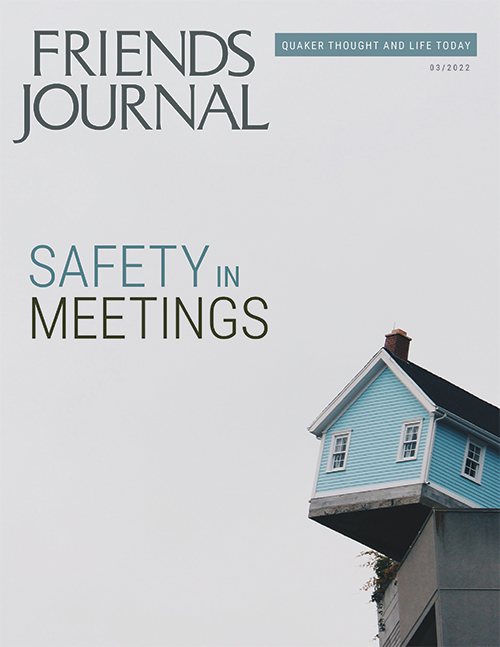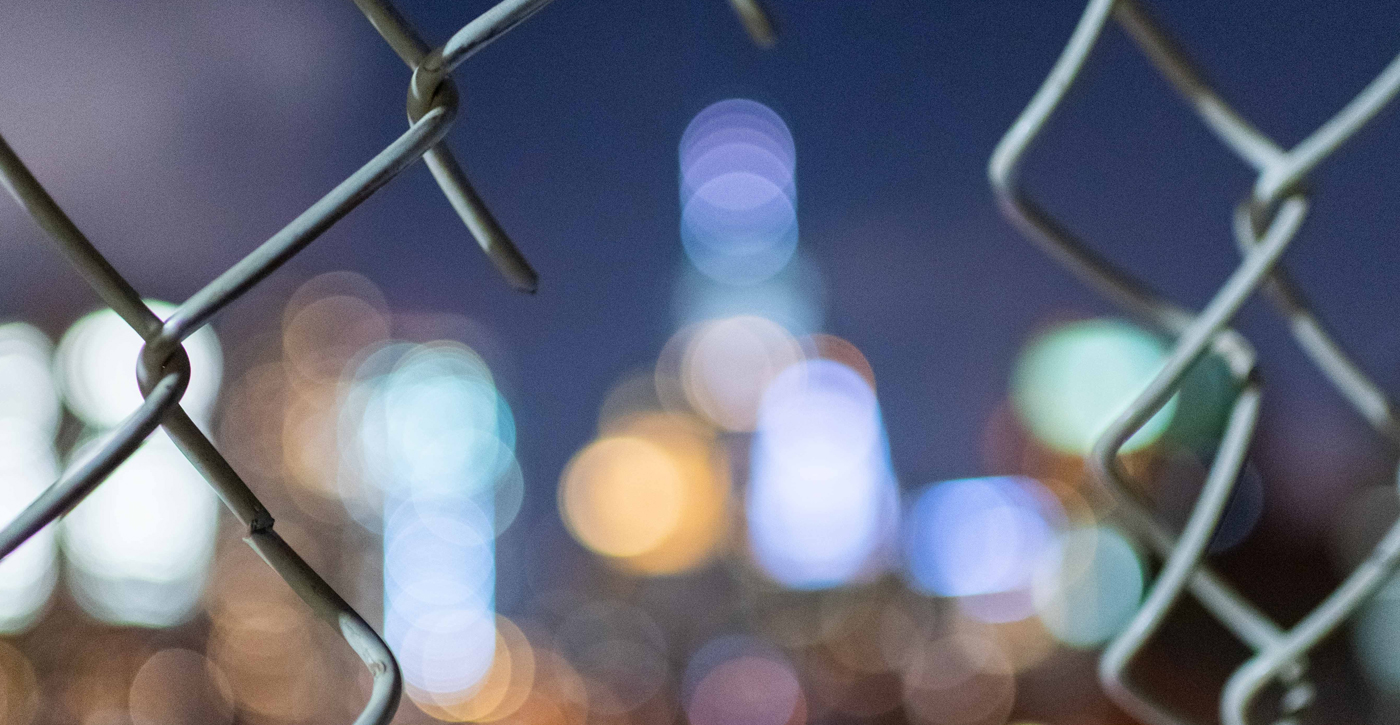A Story That Never Happened
One role of our Quaker communities for centuries has been to minister to people in prison; support those who have been involved in the justice system; and welcome those seeking a spiritual connection, if they make that request. This ministry is more complicated when a person has a history of violent sex crimes. M came to our meeting after serving decades in prison and had a Level III Registered Sex Offender (RSO) designation. This designation means the person has a high likelihood of re-offending.
There are many issues to consider in welcoming a Registered Sex Offender (RSO) to a meeting. First, the person’s current behavior is as important to evaluate as their past conviction and history of offenses. Second, the meeting needs to have the capacity to find common ground for setting boundaries and procedures that support the RSO and the vulnerable people in the community through deep education, on-going training, and policy creation. Third, the person must be willing to abide by agreed upon restrictions. Finally, the meeting must assess its own courage as a whole to work together to enforce boundaries, support sacred space, and create safety for all.
In this scenario, the meeting had to weigh the safety and well-being of their members and attenders with the values of forgiveness and redemption that Quakers have known for centuries to be our vital work. The question was how. Some suggested there are some people that should not be allowed in our meetings at all, especially those with convictions and history of violent sexual crimes. Still, others asserted that it is possible to create circles of support and accountability for these people and welcome them into our meetings. These Friends said that our meeting could create environments with clear boundaries and accountability, as well as provide regular education and training to the meeting, so that spiritual support for all members of the meeting was possible, even with an RSO worshiping with us. Accomplishing this while attending to the needs of the women who are the same age as were the targets of this person’s past victims was a mighty lift.
So, when M reached out to our meeting, one could imagine the incredible weight of our decision. Many folks were eager and ready to welcome M and his wife with open arms. M had served over 25 years in prison, had gone through Alternatives to Violence (ATV) training and had been out of prison for several years. Others in the meeting were deeply disturbed and in shock with the idea of welcoming an RSO to join our meeting; they felt unsafe.
We came to realize that creating space to support an RSO would be our work for the life of our meeting, as long as M was with us. We had to also come to terms with the reality that every strand of fabric in our meeting would be impacted by our decision to welcome M, and that we would lose members who had been with us for many years. Unless monthly meetings have the capacity to put into place effective practices, it is unwise to undertake the decision to welcome someone like M into their community. We realized that safely welcoming an RSO can be done, but not without significant investment of time, training, planning, deliberation, policies, education, and enforcement of meeting defined boundaries.
Some doubted whether we could safely welcome a Level III RSO into the full life of the meeting. It takes only 90 seconds to commit a sex offense, and there can be effects that continue for years. The offender might harm more than one victim before being discovered. It is not the kind of thing where a meeting can “try it out and see,” particularly when it comes to children. A serial offender knows how to look for his targets, and how to manipulate or threaten them into silence so his behaviors do not come to light. On the other hand, it does seem possible that an RSO could be ministered to and participate in a limited part of meeting life if he were very, very carefully chaperoned and supervised by multiple trained people in the meeting.
Deliberation
We immediately brought in professionals who had experience working with faith communities to educate us about the implications of this decision, not just for the safety and well-being of the children and women in the meeting but for M himself. We set in motion deep worship to allow Spirit to move and work among us so we could come into unity about the way forward.
It became very clear that without meeting-wide, in-depth education about the implications of this decision, we could not move forward. We also wanted to make sure that we created a welcoming space and a care committee for M. Many in our community felt that because he had served his time, exhibited mild-mannered behavior, and expressed interest in serving in a leadership role on several of our committees, he was worthy and ready to join. There was a kind of joy from his good friends who advocated for his integration into our community, to trust him, take precautions, and move forward. This was countered by concern that his current behavior demonstrated disturbing patterns of RSOs. This enthusiasm had to be considered in the light of RSOs often using church attendance as a way to be seen as being free of guilt and indispensable in important roles.
Circles were hosted for survivors of sexual violence and sexual abuse, and these safe spaces encouraged conversation and dialogue. Though reluctant, survivors were engaged in the deliberation about whether or not to move forward and how to do that; they were included in every decision-making process. Survivors were not only invited but were given leadership roles in all of the meetings held to discern the path forward. The safety of women and families was prioritized. Their concerns were not diminished or disregarded but integrated. Concerns regarding child safety were heard and addressed, and we benchmarked best practices from other religious communities to create strong procedures to protect children and young women from abuse in the meeting.
Planning
We decided to take a year to discern and prepare our meeting for welcoming M into our community. A group of men stepped forward to meet weekly and worship with M. They built a relationship and connection with him to begin to create a circle of support and accountability. This took a lot of listening among different contingencies in our meeting, because many wanted him to join the meeting right away, but others felt as though both our community and he had to take time to prepare. Care committees were also set up for the Friends in the meeting who were deeply traumatized by the decision to welcome M. Frankly, they were in shock.
But because the meeting set aside one year for education and training, and organized a group of men who were not known to him that he could rely on to help him with triggers, we enabled the trust-building that needed to happen if we were to welcome him. Because M was repentant, he did not resist these restrictions. M was in therapy and was humble, aware of his condition and his path. The meeting leadership listened to women and men about their concerns. Any behaviors that gave rise to victim-shaming were confronted and resolved; compassion and empathy were present for both M and the women who were suffering. The meeting validated their concerns and invited them to engage in the process, although only a small number could participate.
The meeting spent a month looking for, interviewing, and meeting with professionals who had effectively done work integrating sex offenders into faith communities. We learned that education and ongoing training needed to happen on many levels in order to keep M safe and keep the women and families in our meeting safe. We learned about the mindset of people who have committed violent sex crimes and the kind of support they needed. We also learned about best practice to educate our community.
The humility exhibited by M gave rise in our meeting to a sense of hopefulness. He understood and accepted the parameters set forth by our meeting to meet first for a year with the men. He understood that the boundaries set forth were to ensure that he was safe, and others were safe in meeting. He was responsive to the needs of the meeting and the women, and the time we needed to plan and prepare. He understood that he needed to acknowledge his past and the daily work he must do to be healthy.
Education
We understood from the beginning of M’s approach to our meeting that compassion for him was critical. We knew that the best possible support we could provide to M was an environment of love that included accountability, structure, and support. We immediately brought in speakers and consultants, pored over materials, and educated ourselves about the mindset of a person who has committed multiple violent sexual crimes. We educated ourselves about what behaviors a person with this background can exhibit: for example, manipulation and defiance that are hard to shake when an individual seeks and abuses power. We also explored best practices for creating boundaries in faith communities that help everyone be aware and safe. We learned that communities with good boundaries that are clear and enforced create spaces where sex offenders, both known and unknown, have a harder time grooming potential victims and exhibiting problem behaviors.
We learned that some violent sexual offenders who actively seek help can sometimes come to terms with their illness. Taking action through therapy and having a support team to pay attention to daily triggers—or emotions that arise when being proximate to targets—were important components for recovery from engaging in violent sex offenses.
We also learned that a level of empathy and compassion for the vulnerable people involved in a community (women, survivors, and children) indicates the community’s readiness to integrate an RSO into the community. During this year, we learned how violent sexual crimes are not about sex but about power. When the thirst for power is held in check, there is less risk of re-offending.
Training
Although we didn’t have complete unity in our meeting about what training was necessary, we spent a year with representatives from all of our committees looking at different curricula that would be valuable. We landed on trauma-informed care training, consent curriculum through EVERFY, and child safety training through Safe Church.
Everyone in our community learned about trauma-informed care and what’s required of us if we want to have a compassionate community. Members of the community also learned about consent and how to support all of our community, including victims of sexual harassment and assault.
We all developed a better understanding of what it means to give and get consent. We built capacity in each of us, including both younger and older people, to know and understand the vital role consent plays in human relationships. We learned that we needed to be relentless in our awareness and practices because it just takes one instant for there to be a problem. However, when a whole meeting is educated, everyone is involved in creating safe spaces, people are trained as monitors, the RSO signs a contract to abide by the community’s boundaries, and the whole community benefits from the safety and mutual trust created.
Our meeting is healthier because we are tending to the needs of each other. With a broader lens that goes beyond just keeping a safe space with M in our midst, we are looking at what it takes to create a healthy environment for everyone. The point of these steps was to create safe space as well as to ensure best practices, and spiritual discernment are at the core of our decision making.
We realized early on that our decision to welcome M would be all-consuming. It would require ongoing training; vigilance for generations; and losing members, attenders, and families. We would suspend or reduce our efforts on our other priorities for over three years. This decision would change all of us forever. This would be the focus of our work. This is the work of Quakers, but the level of caution, love, and care is exhausting. Meetings need to know this and have the capacity to take on this decision, if they are to be successful.
Policy Formation and Accountability Structure
To prepare a way forward, a balanced committee of diverse-minded members and attenders was formed. Because this was new ground for the monthly meeting, great care was taken to form new structures that would hold and preserve the integrity of the committee’s work. Whereas, the old structure would favor “Weighty Friend” perspectives, this new structure/wineskin would invite new perspectives from diverse members and attenders, who identify as male or female. Outside elders’ perspectives were also invited to ensure the committee process was Spirit-guided. Friends representing divergent (and even clashing) viewpoints were critical to the work of the committee, including the participation of Black, Indigenous, and People of Color (BIPOC) and Young Adult Friends (YAF).
The committee initially stumbled when discussing whether to simply welcome the RSO with minimum oversight. While committee members agreed that a policy was necessary for satisfying expectations of the meeting’s insurance and acceptance for “that of God” in this person, members were stuck on the degree of oversight necessary for safety.
Committee members resisted specifying how this person or any person in meeting for worship should behave, especially when M did not appear to be a threat.
The committee sought insight from the RSO after the policy and procedures were complete. He provided his perspectives on where the weaknesses were, what to watch for, and what would make the procedures clearer. It was he who proposed that it would be a mistake to proceed without a guiding policy, or with a “mistaken understanding of God’s love for all people.” The committee was advised to understand and accept people who have come to terms with their sexual offenses as also having “that of God.”
M agreed to sign the document that created a clear set of behavioral boundaries for him to abide by and the meeting could monitor and enforce. He understood that our meeting would follow-up with the yearly meeting to track if he moved to another meeting if something happened in our meeting. He was not allowed to be alone with anyone in the meetinghouse at any time. He was not allowed to approach any targets in the meeting.
To enforce these boundaries, we created an accountability mechanism: a checklist of procedures and guidelines with clearly assigned enforcement mechanisms. If he violated any of the meeting affirmed guidelines for his behavior, he would be asked to leave and not return to our meeting. The meeting empowered two friends, the clerk of the meeting and one Friend with technical training. The policy would not be evaluated or enforced on a case by case basis on the floor of business meeting. The meeting came to unity on the policy of these two Friends being able to document what happened and report the incident to authorities, if necessary. Additionally, these Friends should require M to leave the meeting and not come back, should M violate any policies. As a meeting, we knew that if there were not a clear procedure that we all believed to be truly actionable, requiring M to leave our meeting, there was not any true capacity to protect members against sexual predators. After years of loving and caring thoughtful work, we have welcomed M into our meeting. Although he thought it could never happen, we persevered.
Lessons Learned
One unintended benefit of this process was the development of standardized practices that other monthly and yearly meetings have implemented to prevent child abuse. We required annual child abuse prevention trainings provided by Safe Church for all people in our meeting who cared for children, participated in children’s program activities, or taught First-day school. We implemented simple policies to protect children in our meeting. For example, no adult was ever to be alone with a child at meeting, unless that adult was the child’s parent or guardian or had explicit permission from the child’s parent. All interactions between adults and children involved more than one adult being present in the room or in the car on trips.
We learned many things welcoming M to our meeting. We saw that the safety of women and children must be the first priority in our meeting. We learned that having the courage to define strong boundaries and hold the people in our meeting accountable for their behavior is central to creating a safe environment for everyone.
A Story that Never Happened
Although we would have liked our experience to unfold this way, this is a fictionalized description of what could have occurred had we handled a similar situation with greater care. Instead, there has been a split in our meeting, which we may, at some point, overcome in the future. In the meantime, massive damage has been done to the well-being of our community, M’s sense of belonging, and the safety of women. Almost all the families have left, as they have felt unsafe. M left the meeting because he disagreed with the weak policy we did eventually adopt. He does not consider himself a sex offender today. Many of our Quaker Friends feel deeply that he should be able to come back with fewer restrictions. Many others would welcome M if he abided with the policies that were in place.
Good people can cause harm to a community because they want to do “the right thing” and welcome people into their midst without adequate precautions. When we ignore the risk RSOs present to Quaker communities that don’t have adequate boundaries or the courage to enforce them, deep spiritual harm will unfold.






Thank you for this article, and your March issue. I wanted to speak as someone who had walked with my meeting into discernment around engaging in support of a convicted pedophile, with the goal of enfolding him into worship and community life. I both love my worship community deeply, and I cannot come to personal clarity to enter into worship with this individual. My clarity is grounded in lived experiences with persons who held power in my life, and who were/are also addicted to alcohol and sex. I believe that, outside of physical and psychological trauma experiences in their early lives, they would not consciously have chosen to cause the sort of deep harm that arose out of their actions manifested on people around them. I cannot possibly know all that they have suffered; and, each did cause real and lasting damage to many people in their paths.
I support the mercy and grace that seems to be in the heart of the meeting’s response to this man and his family. At the same time, the knowledge of his actions triggers PTSD reactions when I approach the idea of worship with him. And it is not possible, nor fair, to expect full understanding by anyone who has not also been a victim or target of an abuser. We have agency – as groups and individuals – to do whatever is required to insure our safety and the safety of those around us. For some number of us, this will require that we step away.
My prayer is that no meetings, or individual Friends, who grapple with this issue will judge anyone one of us who find it necessary to disengage and seek other communities in which to worship, whatever the reason. Likewise, my prayer for those of us who choose to move on is that we also refrain from passing judgement on the meetings or individuals who are clear to move forward.